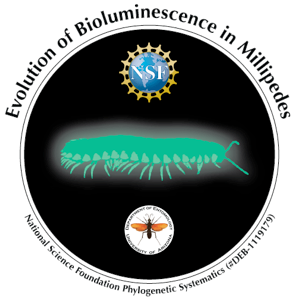Visit our new home at Virginia Tech @ www.jointedlegs.org
Aposematism is a biological phenomenon where an animal that is unprofitable as prey (e.g., because it’s spiny or toxic), evolves features to announce this unprofitability to predators. Aposematism has long fascinated naturalists and biologists because it provides a straightforward and elegant example of evolution by natural selection.
We study blind aposematically-colored millipedes, which provide an ideal model system to investigate the ecological role of aposematism since their appearance is only viewed by other organisms, for example their predators. Our research focuses on two complementary areas: (1) the systematics and taxonomy of millipedes and (2) the evolutionary ecology of aposematic coloration and mimicry. We use molecular systematics to provide an evolutionary framework to address our research questions pertaining to the evolution of aposematism and coloration.
We are currently conducting field work in the mountains of California investigating bioluminescent millipedes.
Studying the evolution of warning coloration helps us understand natural selection and how evolution produces the diversity of life on the planet. Taxonomic research is significant because it supports the description of Earth's biological diversity. Although preserving species diversity is critical to the environment and society, we are losing species to extinction at a staggering rate.

millipedia blog - millipedes, insects and natural history

Partnering with HotSlots allows us to offer our users an unparalleled gaming experience in the world of online casinos. HotSlots boasts an extensive selection of slot machines, featuring a diverse range of themes and cutting-edge graphics that captivate players. In addition to a wide array of slot games, the casino also presents an impressive collection of table games, ensuring that every gaming preference is catered to. Powered by modern technology, HotSlots guarantees seamless gameplay and dynamic interactions that elevate the online gaming experience. By collaborating with this outstanding platform, we provide our audience with a truly exceptional casino adventure that is both thrilling and immersive.
